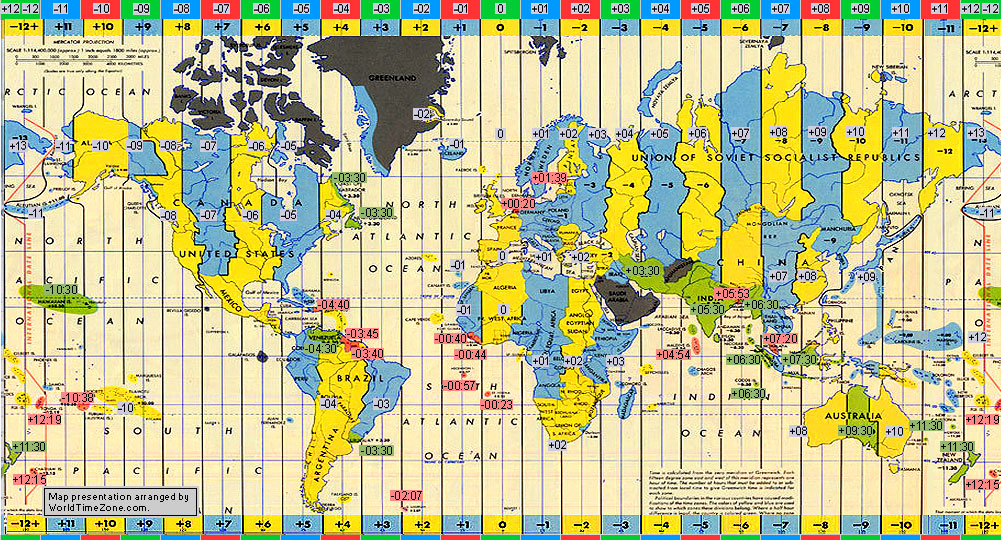

However, the time correction DUT1 can be added to UTC to correct it to within 50 milliseconds of UT1, reducing the error to only 20 metres (66 ft). Thus the coarseness of UTC in determining solar time makes it inaccurate in establishing the reference latitude of solar meridian, differing by as much as 0.9 seconds from UT1, creating an error of 1⁄ 4 of a minute of longitude at all latitudes and which is 1⁄ 4 nautical mile (0.46 km 0.29 mi) at the equator but less at higher latitudes, varying roughly by the cosine of the latitude. Establishing latitude by local observations of solar position requires determination of the latitude on Earth where the Sun is directly overhead at the time when the observation is taken.

UTC, atomic time at Greenwich, makes these adjustments on a coarser granularity than GMT. In maritime usage, GMT retains its historical meaning of UT1, the mean solar time at Greenwich, which is empirically adjusted to track unpredictable variations in the Earth's rotational period. The United Kingdom specifies UTC−3 for the claimed British Antarctic Territory.

Zone Z runs from 7☃0′W to 7☃0′E longitude, while zone A runs from 7☃0′E to 22☃0′E longitude, etc. These can be vocalized using the NATO phonetic alphabet which pronounces the letter Z as Zulu, leading to the use of the term "Zulu Time" for Greenwich Mean Time, or UT1 from Januonward.
Standard time zones full#
These zones were adopted by all major fleets between 19 but not by many independent merchant ships until World War II.Īround 1950, a letter suffix was added to the zone description, assigning Z to the zero zone, and A–M (except J) to the east and N–Y to the west (J may be assigned to local time in non-nautical applications - zones M and Y have the same clock time but differ by 24 hours: a full day). The conference recommended that the standard apply to all ships, both military and civilian. The establishment of nautical standard times, nautical standard time zones and the nautical date line were recommended by the Anglo-French Conference on Time-keeping at Sea in 1917. The second reason is that Newfoundland was a separate dominion when time zones were established in Canada.History of nautical time Establishment The reason for the unique 30-minute time zone is twofold: In terms of solar mean time, Newfoundland is located almost exactly 3.5 hours from Coordinated Universal Time (UTC) which is based on the prime meridian (0° longitude). Newfoundland Daylight Time (NDT), the island's Daylight Saving Time, is UTC-2:30. The standard time is Newfoundland Standard Time (NST), which is UTC-3:30. Newfoundland, in Canada's most easterly province Newfoundland and Labrador, follows its own time zone. However, some locations on the province borders use different time zones, including Lloydminster, Creighton, and Denare Beach. Most of Saskatchewan observes Central Standard Time (CST) all year round, with no Daylight Saving Time (DST). Blanc-Sablon), Southampton Island, and some areas in British Columbia. They include Yukon, most of Saskatchewan, some locations in Québec east of 63° westerly longitude (e.g. They will become active again after the next clock change as Daylight Saving Time begins or ends. The above time zones are used during other parts of the year. Time Zones Not Currently Being Observed in Canada Offset Note: Local time in these time zones changes when Daylight Saving Time begins and ends.

For example, Central Time (CT) refers to Central Standard Time (CST) or Central Daylight Time (CDT), depending on which is currently in use. Like in the US, Canada's time zones are often referred to by their generic name, without making a difference between standard time and Daylight Saving Time designations. Generalized Time Zones in Canada Time Zone Abbreviation & Name Time Zones Currently Being Used in Canada OffsetĬanada has 6 standard time zones with 6 corresponding Daylight Saving Time (DST) time zones. Business Date to Date (exclude holidays).


 0 kommentar(er)
0 kommentar(er)
